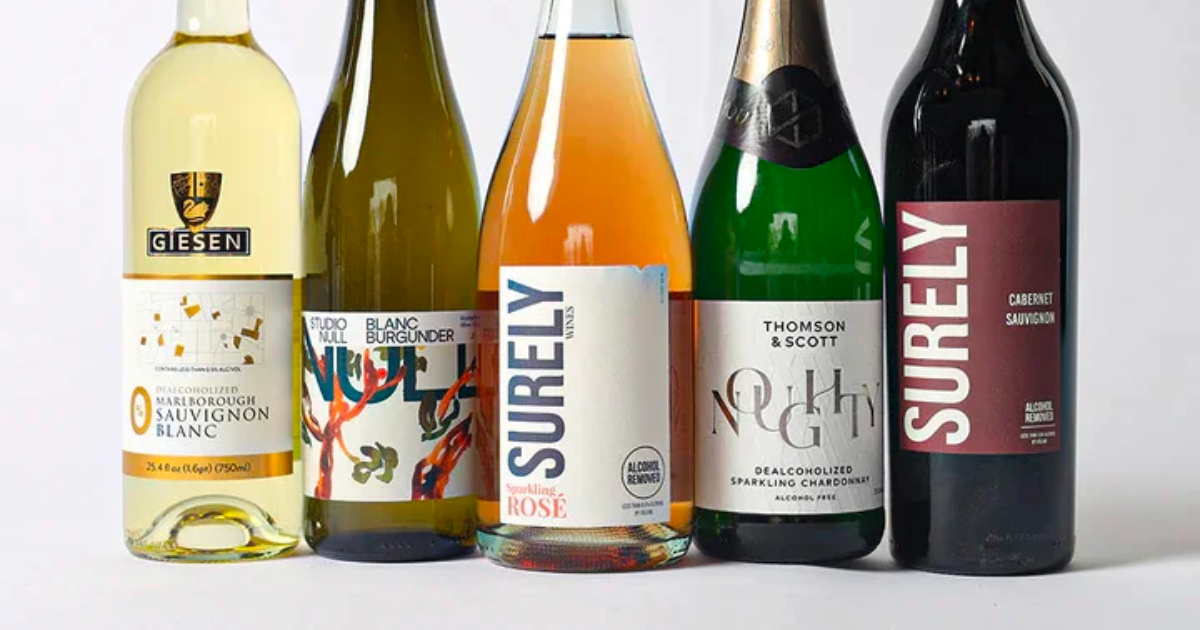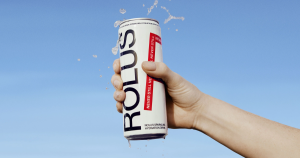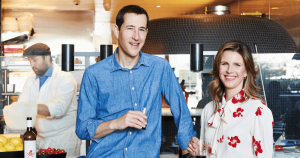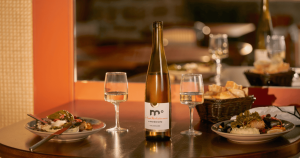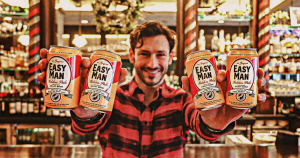For millennia, wine has held a cherished place in human civilization, intertwining itself with our rituals, celebrations, and daily lives. Different varieties of grapes and nuanced production techniques have given birth to a myriad of wine styles, from the bold reds of Bordeaux to the crisp whites of the Loire Valley and the aromatic rosés of Provence.
Beyond its sensory pleasures, wine acts as a social lubricant, a marker of status, and a symbol of the communion between the land and the people who nurture it. As wine’s complexity and cultural significance are appreciated globally, a growing interest in non-alcoholic variants is emerging, offering similar experiences without the alcohol content.
Indeed, in recent years, there’s been a surge in demand for non-alcoholic versions of classic adult drinks, and wine is no exception. But what exactly is non-alcoholic wine? This guide delves into this new category, highlighting its breadth and the best brands to try.
A brief history of wine
The journey of wine, as we understand it today, can be traced back over 8,000 years, making it one of the oldest beverages known to humanity. It’s believed that the earliest winemaking occurred in the regions of modern-day Georgia and Armenia, where wild grapevines were abundant. Early humans discovered that the sweet fruit, once left to ferment, transformed into an intoxicating liquid that not only provided pleasure but also took on significant ceremonial and religious importance.
By 3000 BCE, the art of winemaking had traveled to ancient Egypt, where it became integral to religious ceremonies, particularly in the worship of the god Osiris. It was in ancient Egypt that some of the earliest depictions of winemaking can be found, painted on tomb walls or etched into hieroglyphics. Simultaneously, the Phoenicians were instrumental in spreading viticulture and oenology, the science of wine, throughout the Mediterranean, including to the burgeoning civilizations of Greece and Rome.
The Greeks elevated wine to a new level of cultural importance, associating it with intellectualism and hosting symposiums where philosophical discussions were paired with wine consumption. The Romans further cemented the status of wine as a staple of daily life, from the grand feasts of the elite to the common meals of ordinary citizens. They also advanced viticultural practices, developing techniques and classifications that form the foundation of modern winemaking.
With the fall of the Roman Empire, the Christian Church became the guardian of winemaking, with monasteries across Europe maintaining vineyards and refining production methods. The Middle Ages and the Renaissance saw the emergence of regional wine identities, setting the stage for the complex appellation systems of today.
The exploration era of the 15th to 18th centuries brought European grapevines to the New World, sparking the birth of wine industries in regions like South America, South Africa, and, later, Australia and New Zealand.
Today, wine is a global industry, with both age-old traditions and innovative techniques coexisting to produce an array of styles, each telling a story of its origin, its makers, and the ever-evolving history of this timeless beverage.
What is non-alcoholic wine?
Non-alcoholic wine, as the name suggests, is wine that contains little to no alcohol. Typically, non-alcoholic wines contain less than 0.5% alcohol by volume (ABV), a threshold that aligns with many international definitions of “non-alcoholic” beverages.
The process of making dealcoholized non-alcoholic wine starts similarly to that of regular wine. Grapes are harvested, crushed, and fermented. However, once the wine is made, it undergoes additional steps to remove or reduce its alcohol content. “Proxy” style non-alcoholic wines are created without fermentation at all.
How is the alcohol removed?
The aim of wine de-alcoholization processes is to extract the alcohol while retaining as much of the original flavor, aroma, and characteristics of the wine as possible. There are three common methods:
Vacuum distillation
By reducing pressure, this method allows the wine to boil at a lower temperature, which helps in preserving the wine’s original flavors while removing alcohol.
Reverse osmosis
Also used in the production of non-alcoholic beers, this process involves filtering the wine to separate alcohol from the larger molecules of flavors and colors. The alcohol is then distilled out, and the remaining components are blended back together.
Spinning cone column
This high tech method uses centrifugal force and a series of conical discs to separate volatile compounds (like aromas and alcohol) from the wine. Alcohol is distilled away, and the aromas are reintroduced to the remaining non-alcoholic base.
Common styles of non-alcoholic wine
In the vast universe of wines, it helps to simplify things a bit. While the depth and breadth of wines available worldwide go far beyond the categories below, focusing on these can provide a foundational understanding. Let’s dive into these six basic categories that constitute the vast majority of non-alcoholic wines on the market.
Still red
Made primarily from black or red grapes, still reds have been fermented with skin contact, giving them their rich, bold color. From the delicate Pinot Noir of Burgundy to the full-bodied Cabernet Sauvignon of Napa Valley, still reds offer an incredible range of flavors, aromas, and textures. They’re a favorite with hearty meals and are often touted for their aging potential.
Sparkling red
A bit of a rarity in many parts of the world, sparkling red wines challenge the traditional view of bubbly. Most famous among them is Italy’s Lambrusco and Australia’s sparkling Shiraz. Relative to the alcoholic wines, sparkling reds are over-represented in non-alc, with many booze-free brands discovering that sparkling reds offer the depth of flavor coupled with effervescence, making them perfect for those seeking something different yet approachable.
Still rosé
Rosé wines straddle the line between reds and whites. Made using black grapes, the skins are allowed only brief contact with the juice, imparting a beautiful pink hue. Regions like Provence in France are particularly renowned for their rosés. These wines often carry flavors of red fruit, citrus, and florals, making them popular summer sippers and versatile food partners.
Sparkling rosé
Combine the allure of rosé with the vivacity of bubbles, and you get sparkling rosé. Champagne, the iconic sparkling wine region, produces some of the world’s most esteemed sparkling rosés. These wines often have notes of strawberries, cherries, and a touch of brioche, offering complexity with each sip.
Still white
Produced primarily from green grapes or from black grapes with minimal skin contact, still white wines are diverse in flavor profile. Whether it’s the crisp acidity of a Sauvignon Blanc, the buttery roundness of an oaked Chardonnay, or the aromatic allure of a Riesling, white wines offer a spectrum of tastes to suit various palates.
Sparkling white
Celebratory and invigorating, sparkling white wines have captured the imagination of many. From the grandeur of Champagne to the approachable charm of Prosecco or Cava, these wines are made using a secondary fermentation process that introduces carbonation. Their lively bubbles and fresh flavors make them a favorite for toasts and aperitifs. For many mindful drinkers new to non-alc wines, sparkling whites are the best place to start.
Crafting Non-Alcoholic Wine Proxies
Wine proxies offer an intriguing departure from the typical non-alc winemaking process. Unlike dealcoholized wines, which are made by first creating a traditional alcoholic wine and then removing the alcohol, wine proxies bypass fermentation altogether. Instead, they are crafted to mimic the taste, aroma, and mouthfeel of wine using alternative methods.
Ingredient blending
The core of wine proxies is a blend of juices, vinegars, teas and other natural ingredients. Verjus is sometimes the primary base due to its inherent association with wine, but other fruits and botanicals can also be used to replicate the intricate flavor profiles found in traditional wines. Adjustments in acidity, sweetness, and bitterness are carefully managed to mimic the balance of a genuine wine or a gastronomic beverage all its own.
Aromatics and botanicals
To reproduce the nuanced bouquet of aromas found in wine, wine proxies often incorporate natural botanicals, essences, and infusions. This might include everything from oak extracts that impart the vanilla or toast notes typical of barrel aging, to herb and spice infusions that echo the more subtle notes found in some wines.
Texture enhancements
One of the challenges with wine proxies is replicating the mouthfeel of wine, which is influenced by alcohol, tannins, and other compounds. Some producers might use teas, thickeners, carbonation, or other additives to give the liquid a more wine-like texture or sensation on the palate.
While wine proxies aren’t “wines” in the traditional sense, they are gaining traction among those who seek the wine experience without the effects of alcohol. The creativity and innovation behind them make wine proxies a fascinating subset of the non-alcoholic beverage world.
Choosing the best non-alcoholic wine
Choosing the best non-alcoholic wine depends on individual preferences, the occasion, and what you’re looking for in a wine experience. Here are some steps and considerations to guide you:
Determine the purpose
- Occasion: is it for a celebratory toast, pairing with a meal, or casual sipping? Different occasions might call for sparkling, red, white, or rosé variants.
- Dietary restrictions: some non-alcoholic wines may contain added sugars or other additives. Check the label if you have specific dietary needs.
Brand reputation
Start by researching reputable brands in the non-alcoholic wine space. Brands with a history in the alcoholic wine industry often have the expertise to craft quality non-alcoholic versions.
Newer brands focused solely on non-alcoholic beverages might bring innovation and unique flavors to the table.
Taste test
If possible, attend tastings at your local non-alc bottle shop or purchase sample-sized bottles. Just as with alcoholic wines, personal preference plays a significant role. What resonates with one individual might not be a hit with another, so sampling a few varieties can help you pinpoint your favorite.
Read reviews
These can give you insights into taste, aroma, and overall quality. Remember that wine, even non-alcoholic, is subjective. What one person loves, another might dislike.
Consider proxies
If you’re open to non-traditional options, explore wine proxies. Especially if you’ve been disappointed by dealcoholized wines you’ve tried. These aren’t made through fermentation but are crafted to mimic the wine experience.
Pairing with food
Much like traditional wines, consider what you’ll be eating. Lighter dishes might pair well with a non-alcoholic white or rosé, while heartier meals might benefit from a red. Check pairing recommendations on the brand’s website.
Trust your palate
Ultimately, the best non-alcoholic wine is the one you enjoy most. Trust your taste buds and don’t be swayed solely by price or popular opinion.
As the demand for non-alcoholic beverages grows, the quality and variety of non-alcoholic wines on the market are increasing. With a bit of exploration, you’re likely to find a bottle that satisfies your cravings and complements your occasions.
The best non-alcoholic wines: a comparison
Here are five of the best booze-free wines I’ve tried.
Allay
Rooted in Washington’s Wahluke Slope AVA, Allay embraces sustainable and organic farming of over 30 grape varietals. They utilize the Spinning Cone Column technique for alcohol removal, ensuring genuine wine flavors. Additionally, they take advantage of the health benefits of organic ashwagandha and reishi, known for their stress-relieving and mood-enhancing properties, respectively.
Surely
Surely Wines crafts premium, non-alcoholic wines with a focus on wellness. Sourced from California’s sun-kissed coast, their wines undergo traditional fermentation, followed by dealcoholization, allowing their winemakers to infuse their unique touch. I love how they offer both canned and bottled wines, perfect for casual picnics and more formal occasions alike.
Gruvi
Gruvi is an innovative brand in the non-alcoholic beverage space, not limiting itself to just wine. Their non-alcoholic wines, however, stand out for their vibrant flavors and commitment to providing healthy, enjoyable alternatives. They’re also vegan and gluten-free. Beyond wine, their portfolio includes beers and other non-alcoholic beverages, emphasizing balance and taste. Try the sangria, my personal favorite!
Blurred Vines by Three Spirit
The only wine proxy on this list, Blurred Vines offers a distinctive blend that merges the invigorating essence of a cold brew botanical mixture, featuring guayusa, black tea, and green tea, with the fruitiness of redcurrant and strawberry juices. The concoction is elevated by a fermented fruit wine base crafted from water, apricot, and white grape juice concentrates. To add depth and complexity, botanical extracts such as hibiscus flower, green tea, schizandra berry, and a hint of cayenne pepper are infused.
Prima Pavé
Prima Pavé is a chic line of non-alc sparkling wines from Italy. Made without adding sugar or chemicals, these wines capture the natural flavors and essence of carefully chosen Italian grapes. In my opinion, you can’t go wrong with any of their three sparklers.
FAQs about booze-free wine
Why would anyone drink non-alcoholic wine?
There are numerous reasons why someone might opt for an alcohol-free wine:
- Mindful Drinking: Many want to reduce their alcohol intake without sacrificing social experiences or the pleasure of savoring a fine Napa Valley Cab.
- Health Reasons: Some individuals abstain from alcohol due to medications, health conditions, or personal wellness goals.
- Safety: Non-alcoholic options allow one to enjoy a sophisticated adult drink without impairing their ability to drive or perform other tasks.
- Gastronomic Mixology: Many of the world’s finest dining restaurants pair non-alcoholic wine proxies with their tasting menus to further elevate the gastronomic experience.
- It’s nice to hold a drink in your hand
How Authentic is the Taste?
Non-alcoholic wines aim to replicate the taste and experience of traditional wines, but there are differences:
- Flavor and aroma: without alcohol, some flavors and aromas might be less pronounced or altered in non-alcoholic wines.
- Mouthfeel: traditional wines have a certain “weight” or texture due to alcohol. Non-alcoholic versions can feel lighter in comparison.
- Aging: while regular wines can evolve with age, non-alcoholic wines are best consumed fresh.
In short, while non-alcoholic wines offer a similar experience, many don’t yet match the depth and complexity of their alcoholic counterparts. However, advancements in production and dealcoholization are rapidly narrowing the gap.
What is the difference between a dealcoholized wine and a wine proxy?
Dealcoholized wine starts as regular wine. Alcohol is removed post-fermentation while trying to keep the wine’s flavors. A wine proxy doesn’t start as wine; it’s a blend of ingredients aiming to mimic wine flavors. It’s crafted to resemble the taste and experience of wine, but isn’t derived from fermented grapes.
How do non-alcoholic wines compare in calorie content?
Alcoholic Wines:
- Main calorie sources: alcohol and sugars.
- A 5-ounce serving typically has 100-150 calories, depending on alcohol and sugar content.
Non-Alcoholic Wines:
- Lacks the calories from alcohol, usually making them lower in calories.
- A 5-ounce serving typically ranges from 20-50 calories, but this varies based on sugar and additives.
In short, non-alcoholic wines generally have fewer calories than alcoholic wines, but the exact amount can differ based on sugar and other ingredients.
What’s the shelf life of non-alcoholic wines?
Without the preserving qualities of alcohol, non-alcoholic wines are more susceptible to spoilage and degradation of flavor. Properly sealed, they can last up to a year unopened, but once opened, it’s best to consume them within 3-5 days. To maximize freshness, they should be stored in a cool, dark place, and after opening, kept refrigerated and sealed tightly. Always check the bottle for specific storage recommendations and expiration dates.
How should I pair non-alcoholic wines with food?
Pairing non-alcoholic wines with food mirrors many of the principles of traditional wine and food pairing. The objective is to complement or contrast flavors, ensuring that neither the wine nor the food overpowers the other. Here’s a general guide:
Light and crisp whites
- Pair with: light dishes like salads, seafood, chicken, or vegetarian fare.
- Reason: these wines don’t overwhelm delicate flavors.
Full-bodied whites
- Pair with: richer dishes like creamy pastas, lobster, or roast chicken.
- Reason: the weight of the wine matches the weight of the food.
Rosés
- Pair with: grilled vegetables, light salads, or Mediterranean dishes.
- Reason: rosé’s versatility complements a variety of flavors.
Light reds
- Pair with: grilled chicken, salmon, or vegetarian pizzas.
- Reason: the wine’s light tannins won’t overshadow the dish.
Full-bodied reds
- Pair with: red meat, barbecued dishes, or hearty pastas.
- Reason: rich wines stand up to and complement robust flavors.
Sparkling wines
- Pair with: Appetizers, sushi, or salty snacks.
- Reason: The effervescence and acidity cut through salt and enhance flavors.
Sweet wines
- Pair with: Desserts, blue cheeses, or spicy dishes.
- Reason: The wine’s sweetness complements or contrasts the dish’s flavors.
Acidity matters. A wine with high acidity feels crisp and can balance dishes with fat or salt. Also consider ingredients and preparation: Ingredients like lemon or tomatoes can influence a dish’s acidity and affect pairing choices. Ultimately, trust your palate. Taste is subjective. What works for one person might not work for another, so trust your instincts and enjoy the experimentation. Remember, while these are guidelines, the best pairings often come from personal preferences and experimentation. Don’t be afraid to try different combinations to find what works best for you.
What are the health benefits of non-alcoholic wine?
Non-alc wines are often rich in antioxidants, especially polyphenols like resveratrol, that can contribute to heart health and improved circulation. Without alcohol, these wines reduce the risk of impaired judgment, liver issues, and addiction associated with alcohol consumption. Additionally, they often contain fewer calories than their alcoholic counterparts, supporting those mindful of their caloric intake. As with any beverage, moderation is key, but non-alcoholic wines present a healthier alternative for wine enthusiasts.
Is there any residual alcohol in non-alcoholic wine?
Dealcoholized beverages are typically reduced to 0.5% alcohol by volume, at least in countries in which that’s the legal standard for “non-alcoholic.” That said, more and more non-alc wine brands are catering to the needs of those who want alcohol-free wine, which contains <0.05% alcohol by volume.
There are many exceptions to the rule, but in general wine proxies tend to be lower ABV than de-alcoholized wines.
For more from Douglas, connect with him on LinkedIn.
Dry Atlas is a media company focused on alcohol alternatives. We deliver non-alcoholic beverage news, insights, and recs to over five million people annually. To stay up to date on all things non-alc, subscribe to our weekly newsletter.


